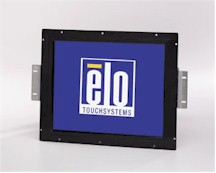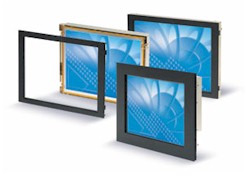News
Touchscreen Applications: Getting in touch with the future
April 25, 2005
What do sunlight, brass knuckles, and size 13 workboots have in common?
All three can damage, or worse yet, ruin your kiosk. Perhaps you didn't take these items into account when you ran the specs for your latest kiosk project. Hopefully, it's not too late to fine tune your plans and spend a little extra time choosing the proper display and touchscreen combination for your application. There is also time to think outside of the box and expand your kiosk horizons to include multiple displays, outdoor applications, larger screens, and an expanded definition of the word "kiosk."
Here comes the sun - and new kiosk applications
Until recently, the warming rays of the sun prevented kiosk deployments in the great outdoors. Kiosk applications for amusement parks, stadiums, and gas stations were susceptible to overheating. The combination of solar effect (infrared heating) ambient temperature and component-generated heat would all contribute to multiple component failure within the kiosk. The display and touch screen would take the brunt of the sun's ultraviolet rays and their damaging effect. According to Alice Moran, marketing manager for 3M Touch Systems (Methuen, MA), a new solar reflecting film used on 3M's Near Field Imaging touchscreens does just what its name implies. It reflects the infrared rays of the sun, minimizing the solar effect on the display, and helping to reduce overall heat build-up in outdoor kiosks. This new 3M film technology means that seat-back applications - touch-enabled displays installed on the backs of seats and used to order food, drink, and instant replays - may soon be the norm in stadiums. Currently, this type of application is limited to indoor luxury boxes. Moran points out that seat-back kiosks can be used successfully in colder weather. "Cold is not as much of an issue as heat," she says.
3M's Paul Baril, monitor marketing manager, adds that readability and viewing angle are important considerations, regardless of kiosk location. For applications like retail, information, and advertising kiosks, viewability from a wide range of angles is paramount. Viewing angle, combined with dynamic content is used to draw users in. On the other hand, in certain applications, privacy is becoming an issue, notes Baril. After all, nobody wants to share their ATM pin number or credit card information with the person waiting in line behind them at the kiosk. A 3M light control film can be used on displays to actually reduce the display viewing angle and thereby greatly increase user privacy. Popular markets for this technology include retail, banking, and healthcare.
Is there room for one more?
If one display screen is good, wouldn't two be even better? Kiosk users needn't stand idly by waiting for their transactions to be processed. Instead users can view a variety of advertisements and up sell suggestions via a secondary display mounted near the transaction screen, according to Paul Wiener, marketing manager for Elo TouchSystems, Inc. (Fremont, CA).
Applications utilizing secondary displays can include video streaming coupled with MP3 downloads at the airport and coupon dispensing in grocery stores, according to 3M's Baril. Pay-at-the-pump kiosks easily incorporate secondary displays for food ordering and grocery selection at gas station/C-stores.
 |
 |
One for all, and all-in-one
When it comes to today's kiosks, maybe you've considered an all-in-one PC. A desktop application, for example, may warrant an all-in-one PC. Wiener suggests this solution may solve the problem of too-little space. "All-in-one PCs are sometimes used in point of sale applications, kiosk application systems, and internet access points," says Wiener. "In a public use application, the concern is the permanency of having the display and the PC together."
Baril cited the example of a disgruntled worker (with the size 13 workboot) or the angry customer who smashes the touchscreen on an all-in-one unit. If the display is damaged, your entire kiosk is damaged. The unit as a whole must then be replaced, rather than the less-expensive touchscreen only. To get around this, savvy kiosk manufacturers will us a PC located in a "safer" part of the kiosk, and integrate the kiosk monitor with a vandal-resistant touchscreen technology such as 3M's ToughTouch or Near Field Imaging technology. Not only does it become much harder to damage the display and touchscreen, but if one succeeds in doing so, your PC is (hopefully) still safe.
While it is too soon to tell, the all-in-one PC may be the form that government-mandated electronic voting machines take in the near future. The all-in-one PC application is currently used in self-check in at trade shows now, for example, states Moran.
Different display sizes
Moran adds that the term kiosk is changing to include more applications such as the self check-in. "The term kiosk is changing to mean more self-serve," says Moran. "People want faster, more accurate service, including self-serve at the checkout. This trend will continue. But think of the kiosk market as advertising." As cell phones and PDAs become smaller, the trend for touchscreen size seems to be towards larger formats. Moran points to 42" displays used at trade shows for advertising and promotional purposes.
The increase in display size is certainly a trend, according to Wiener. "The 17" is popular and demand is growing for 19" inch displays," he notes, while adding that growing markets for these larger displays include self-serve, education and government applications.
Compare apples to apples
Baril offers some advice to those charged with investing company dollars in kiosk rollouts. "The display is the face of your kiosk and you need to be aware of what is a good display versus a bad display. A dim, muddy display with low brightness and contrast will make any kiosk look mediocre." Baril likens the cost of touch monitors to the cost of building a house. Two builders will quote you differently on a 2,500-square-foot-house when one builder is using crown molding and ceramic tile and the other builder is using less expensive materials. That's why, when it comes to specifying the touch monitor for your kiosk, be certain you are comparing apples to apples. Look for rugged display enclosures, high brightness and contrast ratios, and wide viewing angles. As a general rule, you'll pay more for higher ratings.
The various types of touch technology each have their own particular strengths which can be used to maximize the kiosk performance. Capacitive touchscreens offer an all-glass solution that increases robustness. Resistive touchscreens utilize a polyester top sheet over the glass substrate. While this technology is less expensive, it may not be as durable for your particular kiosk environment. Resistive touch technology is popularly used in retail and point of sale applications and for small, portable devices such as PDAs. Surface acoustic wave touchscreen technology is all-glass solution which delivers the ultimate in image clarity and light transmissions, preserving color purity, and, because there are no overlays, works even if scratched. Infrared technology, another pure glass technology, operates in extreme temperature, shock and vibration, and lighting conditions providing high durability, vandal resistance, and sealability. Other touch technologies include projected capacitive, Near Field imaging, and infrared. The market offers several touch technology options, each having its own particular strength for a particular environment. When designing your kiosk, consider the application and the environment. Is the kiosk employee-operated or customer-operated, used with gloved hands or bare hands, supervised or unsupervised, indoor or outdoor, used in extreme temperatures, or used near food or chemicals? Based on this analysis, you will be able to determine the best touchscreen solution.
Kiosks here to stay
So, even if the guy with the size 13 workboot ruins a kiosk, he won't destroy the kiosk market. Baril reminds us that when properly planned, deployed, and maintained, kiosks can do a lot for you. "Kiosks can provide a great ROI, deliver a great consistency of messaging, deliver a dynamic media (think signage and point of purchase), and are tireless workers." Baril points to one last dynamic application used at a grocery store as an example of how kiosks prove their worth. Onboard shopping companions are attached to the grocery cart. These companions are small display screens that remind the customer what was purchased during the last visit and what is on sale now or what may be needed by the customer this time, based on past shopping history. It's personalized service similar to what you would receive in a small store years ago. And in today's fast-paced, technology-driven world, who couldn't use more service like that?
Research
www.3mtouch.com
www.elotouch.com
Originally published in the Mar/Apr 2004 issue ofKioskmagazine.







